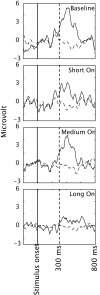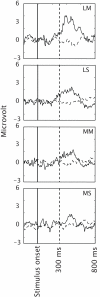A tactile P300 brain-computer interface
- PMID: 20582261
- PMCID: PMC2871714
- DOI: 10.3389/fnins.2010.00019
A tactile P300 brain-computer interface
Abstract
In this study, we investigated a Brain-Computer Interface (BCI) based on EEG responses to vibro-tactile stimuli around the waist. P300 BCIs based on tactile stimuli have the advantage of not taxing the visual or auditory system and of being potentially unnoticeable to other people. A tactile BCI could be especially suitable for patients whose vision or eye movements are impaired. In Experiment 1, we investigated its feasibility and the effect of the number of equally spaced tactors. Whereas a large number of tactors is expected to enhance the P300 amplitude since the target will be less frequent, it could also negatively affect the P300 since it will be difficult to identify the target when tactor density increases. Participants were asked to attend to the vibrations of a target tactor, embedded within a stream of distracters. The number of tactors was two, four or six. We demonstrated the feasibility of a tactile P300 BCI. We did not find a difference in SWLDA classification performance between the different numbers of tactors. In a second set of experiments we reduced the stimulus onset asynchrony (SOA) by shortening the on- and/or off-time of the tactors. The SOA for an optimum performance as measured in our experiments turned out to be close to conventional SOAs of visual P300 BCIs.
Keywords: BCI; BMI; P300; somatosensory; tactile.
Figures







References
-
- Bledowski C., Prvulovic D., Hoechstetter K., Scherg M., Wibral M., Goebel R., Linden D. E. J. (2004). Localizing P300 generators in visual target and distracter processing: a combined event-related potential and functional magnetic resonance imaging study. J. Neurosci. 24, 9353–936010.1523/JNEUROSCI.1897-04.2004 - DOI - PMC - PubMed
LinkOut - more resources
Full Text Sources
Miscellaneous

